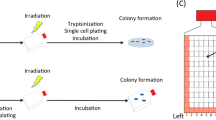Abstract
Despite the long history of using cell cultures in vitro for radiobiological studies, there is to date no study specifically addressing the dosimetric implications of flask selection and exposure environment in clonogenic assays. The consequent variability in dosimetry between laboratories impedes the comparison of results. In this study we compare the dose to cells adherent to the base of three types of commonly used culture flasks or plates. The cells are exposed to a 6MV clinical photon beam using either an open or a half blocked field. The depth of medium in each flask is varied with the medium surrounding the flask either water or air. The results show that the dose to the cells is more affected by the scattering conditions surrounding the flasks than by the level of filling within the flask. It is recommended that water or a water equivalent phantom material is used to surround the flasks or plates to approximate full scatter conditions at the cell layer. However for modulated fields, surrounding the 24 well plates with water-equivalent material is inadequate because of the large volume of air surrounding individual wells. Our results stress the importance of measuring the dose for new experimental configurations.





Similar content being viewed by others
References
Sjostedt S, Bezak E (2010) Non-targeted effects of ionising radiation and radiotherapy. Australas Phys Eng Sci Med 33:219–231
Butterworth KT, McGarry CK, Trainor C, Sullivan JM, Hounsell AR, Prise KM (2011) Out-of-field cell survival following exposure to intensity-modulated radiation fields. Int J Radiat Oncol Biol Phys 79:1516–1522
Claridge Mackonis E, Suchowerska N, Zhang M, Ebert M, McKenzie DR, Jackson M (2007) Cellular response to modulated radiation field. Phys Med Biol 52:5469–5482
Kellerer AM, Roos H (2005) Are all photon radiation similar in larger absorbers?-a comparison of electron spectra. Radiat Prot Dosim 113:245–250
Pattison JE, Hugtenburg RP, Charles MW, Beddoe AH (2001) Experimental simulation of A-bomb gamma ray spectra for radiobiology studies. Radiat Prot Dosim 92:125–136
Harder D, Petoussi-Henß N, Regulla D, Zankl M, Dietze G (2004) Radiat Prot Dosim 109:291–295
Altman MB, Vesper BJ, Smith BD, Stinauer MA, Pelizzari CA, Aydogan B, Reft CS, Radosevich JA, Chmura SJ, Roeske JC (2009) Characterization of a novel phantom for three-dimensional in vitro cell experiments. Phys Med Biol 54:N75–N82
Moiseenko V, Duzenli C (2007) In vitro study of cell survival following dynamic MLC intensity-modulated radiation therapy dose delivery. Med Phys 34:1514–1520
Sterzing F, Münter MW, Schäfer M, Haering P, Rhein B, Thilmann C, Debus J (2005) Radiobiological investigation of dose-rate effects in intensity-modulated radiation therapy. Strahlenther Onkol 181:42–48
McGarry CK, Butterworth KT, Trainor C, O’Sullivan JM, Prise KM, Hounsell AP (2011) Temporal characterization and in vitro comparison of cell survival following the delivery of 3D-conformal, intensity-modulated radiation therapy (IMRT) and volumetric modulated arc therapy (VMAT). Phys Med Biol 56:2445–2457
Seymour CB, Mothersill C (1989) Lethal mutations, the survival curve shoulder and split-dose recovery. Int J Radiat Biol 56:999–1010
Keall P, Chang M, Benedict S, Thames H, Vedam SS, Lin P-S (2008) Investigating the temporal effects of respiratory-gated and intensity-modulated radiotherapy treatments delivery on in vitro survival: an experimental and theoretical study. Int J Radiat Oncol Biol Phys 71:1547–1552
Ling CC, Li WX, Anderson LL (1995) The relative biological effectiveness of I-125 and Pd-103. Int J Radiat Oncol Biol Phys 32: 373–378
Mu X, Löfroth P-O, Karlsson M, Zackrisson B (2003) The effect of fraction time in intensity modulated radiotherapy: theoretical and experimental evaluation of an optimisation problem. Radiother Oncol 68:181–187
Suchowerska N, Ebert MA, Zhang M, Jackson M (2005) In vitro response of tumour cells to non-uniform irradiation. Phys Med Biol 50:3041–3051
Bromley R, Davey R, Oliver L, Harvie R, Baldock C (2006) A preliminary investigation of cell growth after irradiation using a modulated X-ray intensity pattern. Phys Med Biol 51:3639–3651
Bewes JM, Suchowerska N, Jackson M, Zhang M, McKenzie DR (2008) The radiobiological effect of intra-fraction dose-rate modulation in intensity modulated radiation therapy (IMRT). Phys Med Biol 56:3567–3578
Gow MD, Seymour CB, Byun S-H, Mothersill CE (2008) Effect of dose rate on the radiation-induced bystander response. Phys Med Biol 53:119–132
Xing L, Sun X, Deng X, Kotedia K, Urano M, Koutcher JA, Ling CC, Li GC (2009) Expression of the bifunctional suicide gene CDUPRT increases radiosensitization and bystander effect of 5-FC in prostate cancer cells. Radiother Oncol 92:345–352
Hehlgans S, Lange I, Eke I, Cordes N (2009) 3D cell cultures of human head and neck squamous cell carcinoma cells are radiosensitized by the focal adhesion kinase inhibitor TAE226. Radiother Oncol 92:371–378
International Atomic Energy Agency (2000) absorbed dose determination in external beam radiotherapy. Technical report series no 398, IAEA, Vienna. pp 210–214
Lui L, Prasad SC, Bassano DA (2003) Evaluation of two water-equivalent phantom materials for output calibration of photon and electron beams. Med Dosim 28(4):267–269
Acknowledgments
The authors acknowledge funding from the NSW Cancer Council in support of this research.
Author information
Authors and Affiliations
Rights and permissions
About this article
Cite this article
Claridge Mackonis, E., Suchowerska, N., Naseri, P. et al. Optimisation of exposure conditions for in vitro radiobiology experiments. Australas Phys Eng Sci Med 35, 151–157 (2012). https://doi.org/10.1007/s13246-012-0132-6
Received:
Accepted:
Published:
Issue Date:
DOI: https://doi.org/10.1007/s13246-012-0132-6




